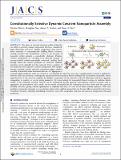Constitutionally selective dynamic covalent nanoparticle assembly
Abstract
The future of materials chemistry will be defined by our ability to precisely arrange components that have considerably larger dimensions and more complex compositions than conventional molecular or macromolecular building blocks. However, exerting structural and constitutional control in the assembly of nanoscale entities presents a considerable challenge. Dynamic covalent nanoparticles are emerging as an attractive category of reaction-enabled solution-processable nanosized building block through which the rational principles of molecular synthetic chemistry can be extended into the nanoscale. From a mixture of two hydrazone-based dynamic covalent nanoparticles with complementary reactivity, specific molecular instructions trigger selective assembly of intimately mixed heteromaterial (Au–Pd) aggregates or materials highly enriched in either one of the two core materials. In much the same way as complementary reactivity is exploited in synthetic molecular chemistry, chemospecific nanoparticle-bound reactions dictate building block connectivity; meanwhile, kinetic regioselectivity on the nanoscale regulates the detailed composition of the materials produced. Selectivity, and hence aggregate composition, is sensitive to several system parameters. By characterizing the nanoparticle-bound reactions in isolation, kinetic models of the multiscale assembly network can be constructed. Despite ignoring heterogeneous physical processes such as aggregation and precipitation, these simple kinetic models successfully link the underlying molecular events with the nanoscale assembly outcome, guiding rational optimization to maximize selectivity for each of the three assembly pathways. With such predictive construction strategies, we can anticipate that reaction-enabled nanoparticles can become fully incorporated in the lexicon of synthetic chemistry, ultimately establishing a synthetic science that manipulates molecular and nanoscale components with equal proficiency.
Citation
Marro , N , Suo , R , Naden , A B & Kay , E R 2022 , ' Constitutionally selective dynamic covalent nanoparticle assembly ' , Journal of the American Chemical Society , vol. Articles ASAP . https://doi.org/10.1021/jacs.2c05446
Publication
Journal of the American Chemical Society
Status
Peer reviewed
ISSN
0002-7863Type
Journal article
Description
Funding: Engineering and Physical Sciences Research Council - EP/L017008/1, EP/R023751/1, EP/M506631/1, EP/T019298/1; China Scholarship Council.Collections
Items in the St Andrews Research Repository are protected by copyright, with all rights reserved, unless otherwise indicated.

